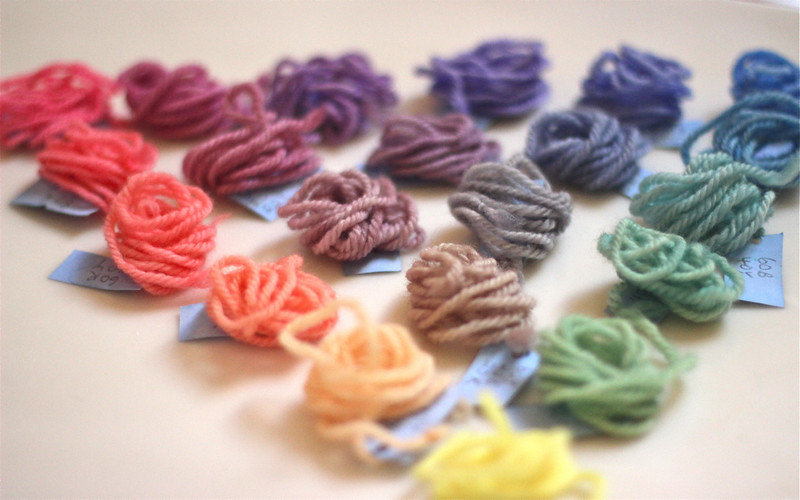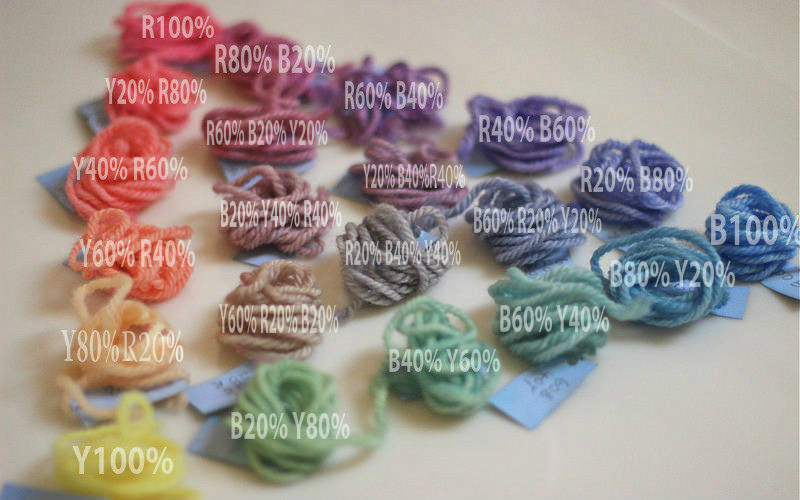Colour Party
Making art has always been a huge part of my life but at school I always had timetabling issues trying to balance art classes with maths lessons. I loved both and although I did toy with the idea of becoming an architect like many of my relatives, little did I know that decades later, knitting would turn out to be my perfect combination of art and maths. It's funny how things work out.
Of course, I'm talking about "knitting" in the broadest sense of the word. Maybe I should say "fibre arts"? It's no secret I am an obsessive knitter but I also get quite a thrill making up my own patterns and I've been well and truly seduced by spinning. Well, my latest adventure has been playing with colour and wool and oh boy - dyeing is SO MUCH FUN!
My first attempts were quite random as I splashed, poured and dipped. I've shown you some of them; my pretty pink socks and my earthy cardigan (both waiting patiently to be finished). While I was quite happy with how they turned out, I decided that I needed to get a better handle on how much dye it really took to make different strengths of colour and I wanted to experiment with the three primary colours (red, yellow and blue) to see exactly how they'd combine to make different colours.
I am not a cook whose strength is measuring accurately but for the purposes of learning a bit more about dyeing, I told myself to knuckle down and have a go. A couple of years ago I heard Annette talk about dye triangles on her podcast Gentle Ribbing. It looked fantastic. She'd done tons of experimenting and made lots of little samples of coloured wool so I started there with her ideas. Working out the maths was pretty intense but I did it in the end!
Basically, what I've got is dye-stock at 20% of full strength, diluted a bunch of times to dye just a tiny bit of wool much the same colour as I would have dyed a 100g skein of wool. The only dyes I used were yellow, blue and hot pink Ashford acid dyes. Apparently hot pink is the closest to pure red in the Ashford range.
The colours at the corners are the 100% yellow, blue and red samples. Along the edges of the triangle the colours are combinations of two of these three colours in 20% increments. So, the apricot colour closest to the yellow is 80% yellow and 20% red and the more orange sample next to that is 60% yellow and 40% red. And so on - red to blue, blue to yellow. Isn't is fascinating how the shades change? I marvelled at the proportions required to make some of those lovely blue/green shades.
It was the mucky shades in the middle that really got me. Oh my, aren't they gorgeous?! Slightly more complicated to create, they use different proportions of all three primary colours. The samples that sit neatly in the corners near the red, yellow and blue are all 60%, 20%, 20% combinations, with the 60% being the primary colour it is closest too. The other three are 40%, 40%, 20% combinations, with the 20% being the primary colour it is furthest from. So the silvery grey shade in the centre of the picture above is only 20% red.
You're probably totally confused by now? Here you go - I've given you an idea of what's what on the picture below.
Of course, this is only a rough guide to colour mixing and if you were really keen you could break down the increments to much smaller amounts to discover the colours in between these ones. But, it's a good start for me.
Funnily enough, I learnt a lot more than just how red changes to blue or blue to yellow by doing this exercise. I did learn about diluting dye and how only a tiny amount creates colour beautifully. I was impressed by the delicious mucky colours I could create with just red, yellow and blue. But mostly, I learnt something that I already knew so well. That is, I'm really not a paint-by-numbers sort of artist, especially when it comes to making colours. I am a haphazard, see-what-happens sort of artist, liberated when I go with what "feels good". I had planned to repeat this exercise with 75% strength dye but I'm not going to. I'm going to play and have fun and see what other lovely colours I can come up with, without too much accurate measuring.
Have you played with dyeing yarn or fibre? I'd love to know what you've learnt.



